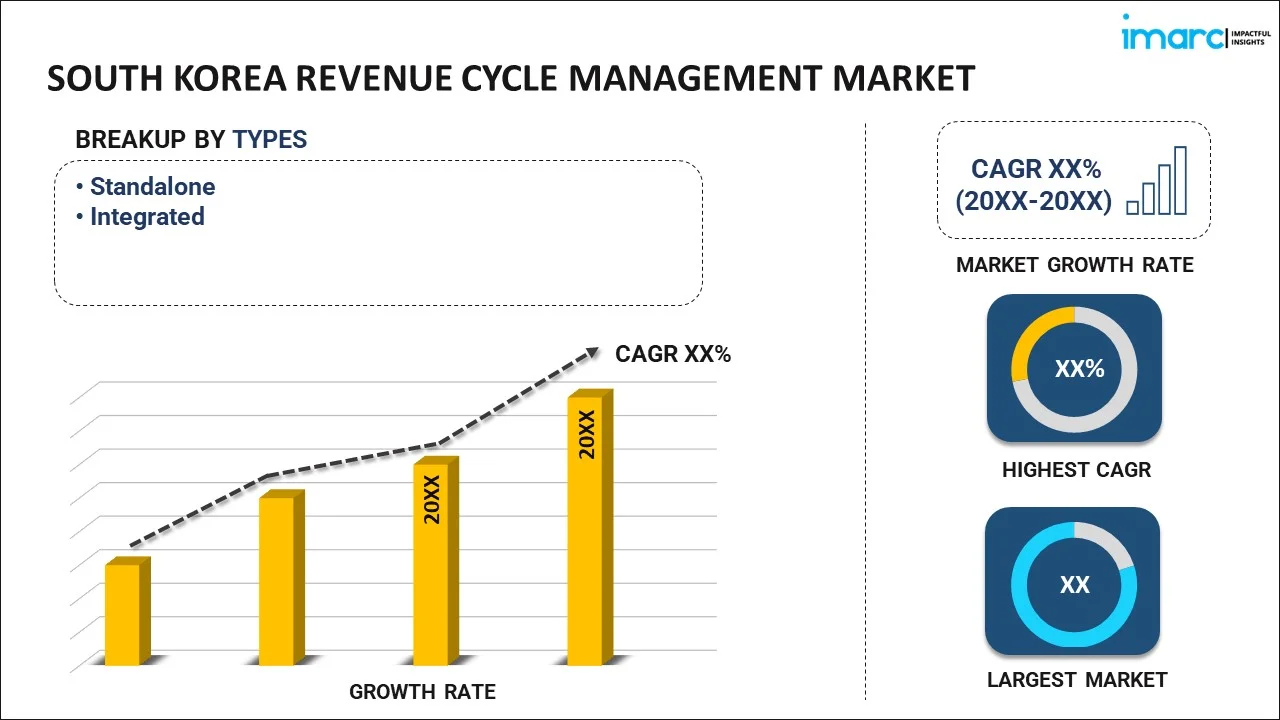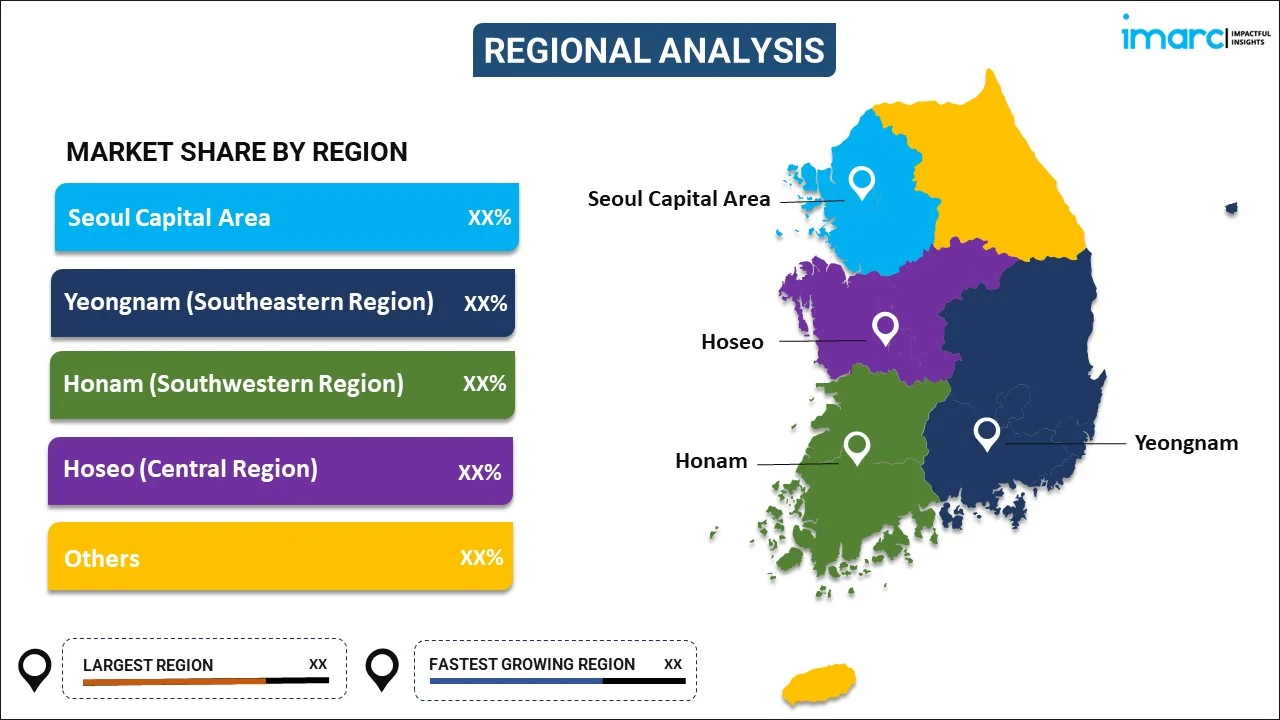
South Korea Revenue Cycle Management Market Report by Type (Standalone, Integrated), Component (Software, Services), Deployment (Web-based, Cloud-based, On-premises), End User (Hospitals, Physicians, Diagnostic and Ambulatory Care Centers), and Region 2024-2032
Market Overview:
South Korea revenue cycle management market size is projected to exhibit a growth rate (CAGR) of 12.46% during 2024-2032. The ongoing digital transformation in healthcare, the stringent regulations and compliance standards in the healthcare industry, the paradigm shift from fee-for-service to value-based care models, the growth in healthcare expenditure, and the escalating focus on patient experience are some of the factors propelling the market.
|
Report Attribute
|
Key Statistics
|
|---|---|
|
Base Year
|
2023 |
|
Forecast Years
|
2024-2032
|
|
Historical Years
|
2018-2023
|
| Market Growth Rate (2024-2032) | 12.46% |
Revenue cycle management (RCM) is a critical process within the healthcare industry that encompasses the entire patient journey, from initial contact to final payment. It involves the systematic management of financial transactions, patient information, and administrative processes to optimize revenue for healthcare providers. The primary goal of RCM is to streamline and enhance the financial aspects of healthcare delivery. The cycle begins with patient registration, where accurate demographic and insurance information is collected. Subsequently, it progresses through charge capture, coding, and claim submission to insurance companies. Timely and accurate coding ensures that healthcare services are appropriately billed, reducing the risk of claim denials. The revenue cycle also includes processing payments, whether from insurance companies or patients directly. Efficient RCM systems leverage technology to automate tasks, minimize errors, and accelerate payment cycles. Electronic Health Records (EHRs) play a pivotal role in this process, as they facilitate seamless information exchange between healthcare providers and payers. By optimizing the revenue cycle, healthcare organizations can improve cash flow, reduce billing errors, and enhance overall financial performance.
South Korea Revenue Cycle Management Market Trends:
The market in South Korea is majorly driven by the evolving landscape of healthcare delivery and financial management. As global healthcare expenditure continues to rise, healthcare providers are increasingly focusing on optimizing revenue streams. RCM solutions help providers navigate complex billing processes, reducing revenue leakage and ensuring timely payments. Furthermore, the growing integration of advanced technologies, such as artificial intelligence and machine learning, into RCM systems has significantly improved efficiency. Automation of mundane tasks, predictive analytics for claims processing, and data-driven insights contribute to streamlined operations and enhanced revenue outcomes, catalyzing the market. Besides, the healthcare industry is subject to a myriad of regulations and compliance standards. RCM solutions aid providers in adhering to these regulations, minimizing compliance risks, and avoiding penalties. The evolving regulatory landscape continues to drive the adoption of RCM solutions, propelling market growth. Moreover, the shift from fee-for-service to value-based care models necessitates more comprehensive and accurate reimbursement processes. RCM systems play a pivotal role in ensuring that providers receive appropriate compensation for delivering high-quality care and achieving positive patient outcomes. With increasing deductibles and co-pays, patients are shouldering a greater portion of their healthcare costs. This shift places added importance on efficient billing processes and transparent communication. RCM systems that enhance patient engagement and facilitate clear financial communication are in high demand, bolstering market growth. Additionally, the rapid expansion of telehealth services has introduced new complexities to the revenue cycle, which in turn is resulting in a higher product uptake.
South Korea Revenue Cycle Management Market Segmentation:
IMARC Group provides an analysis of the key trends in each segment of the market, along with forecasts at the country level for 2024-2032. Our report has categorized the market based on type, component, deployment, and end user.
Type Insights:

- Standalone
- Integrated
The report has provided a detailed breakup and analysis of the market based on the type. This includes standalone and integrated.
Component Insights:
- Software
- Services
A detailed breakup and analysis of the market based on the component have also been provided in the report. This includes software and services.
Deployment Insights:
- Web-based
- Cloud-based
- On-premises
The report has provided a detailed breakup and analysis of the market based on the deployment. This includes web-based, cloud-based, and on-premises.
End User Insights:
- Hospitals
- Physicians
- Diagnostic and Ambulatory Care Centers
A detailed breakup and analysis of the market based on the end user have also been provided in the report. This includes hospitals, physicians, and diagnostic and ambulatory care centers.
Regional Insights:

- Seoul Capital Area
- Yeongnam (Southeastern Region)
- Honam (Southwestern Region)
- Hoseo (Central Region)
- Others
The report has also provided a comprehensive analysis of all the major regional markets, which include Seoul Capital Area, Yeongnam (Southeastern Region), Honam (Southwestern Region), Hoseo (Central Region), and others.
Competitive Landscape:
The market research report has also provided a comprehensive analysis of the competitive landscape. Competitive analysis such as market structure, key player positioning, top winning strategies, competitive dashboard, and company evaluation quadrant has been covered in the report. Also, detailed profiles of all major companies have been provided.
South Korea Revenue Cycle Management Market Report Coverage:
| Report Features | Details |
|---|---|
| Base Year of the Analysis | 2023 |
| Historical Period | 2018-2023 |
| Forecast Period | 2024-2032 |
| Units | US$ Million |
| Scope of the Report | Exploration of Historical and Forecast Trends, Industry Catalysts and Challenges, Segment-Wise Historical and Predictive Market Assessment:
|
| Types Covered | Standalone, Integrated |
| Components Covered | Software, Services |
| Deployments Covered | Web-based, Cloud-based, On-premises |
| End Users Covered | Hospitals, Physicians, Diagnostic and Ambulatory Care Centers |
| Regions Covered | Seoul Capital Area, Yeongnam (Southeastern Region), Honam (Southwestern Region), Hoseo (Central Region), Others |
| Customization Scope | 10% Free Customization |
| Report Price and Purchase Option | Single User License: US$ 3699 Five User License: US$ 4699 Corporate License: US$ 5699 |
| Post-Sale Analyst Support | 10-12 Weeks |
| Delivery Format | PDF and Excel through Email (We can also provide the editable version of the report in PPT/Word format on special request) |
Key Questions Answered in This Report:
- How has the South Korea revenue cycle management market performed so far and how will it perform in the coming years?
- What has been the impact of COVID-19 on the South Korea revenue cycle management market?
- What is the breakup of the South Korea revenue cycle management market on the basis of type?
- What is the breakup of the South Korea revenue cycle management market on the basis of component?
- What is the breakup of the South Korea revenue cycle management market on the basis of deployment?
- What is the breakup of the South Korea revenue cycle management market on the basis of end user?
- What are the various stages in the value chain of the South Korea revenue cycle management market?
- What are the key driving factors and challenges in the South Korea revenue cycle management?
- What is the structure of the South Korea revenue cycle management market and who are the key players?
- What is the degree of competition in the South Korea revenue cycle management market?
Key Benefits for Stakeholders:
- IMARC’s industry report offers a comprehensive quantitative analysis of various market segments, historical and current market trends, market forecasts, and dynamics of the South Korea revenue cycle management market from 2018-2032.
- The research report provides the latest information on the market drivers, challenges, and opportunities in the South Korea revenue cycle management market.
- Porter's five forces analysis assist stakeholders in assessing the impact of new entrants, competitive rivalry, supplier power, buyer power, and the threat of substitution. It helps stakeholders to analyze the level of competition within the South Korea revenue cycle management industry and its attractiveness.
- Competitive landscape allows stakeholders to understand their competitive environment and provides an insight into the current positions of key players in the market.
Need more help?
- Speak to our experienced analysts for insights on the current market scenarios.
- Include additional segments and countries to customize the report as per your requirement.
- Gain an unparalleled competitive advantage in your domain by understanding how to utilize the report and positively impacting your operations and revenue.
- For further assistance, please connect with our analysts.
 Inquire Before Buying
Inquire Before Buying
 Speak to an Analyst
Speak to an Analyst
 Request Brochure
Request Brochure
 Request Customization
Request Customization




.webp)




.webp)












